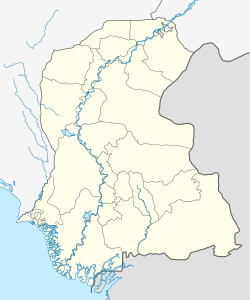Battle of Aror
| Battle of Aror | |||||||
|---|---|---|---|---|---|---|---|
| Part of Umayyad conquest of Sindh | |||||||
 Indus river near Aror | |||||||
| |||||||
| Belligerents | |||||||
| Umayyad Caliphate | Kingdom of Sindh | ||||||
| Commanders and leaders | |||||||
| Muhammad ibn al-Qasim | Raja Dahir † | ||||||
| Strength | |||||||
| 20,000 |
20,000–25,000[1][2] 50,000 (modern estimates) | ||||||
Location within Sindh | |||||||
The Battle of Aror took place in 711 AD between the Umayyad forces under Muhammad ibn al-Qasim and the army of the Brahmin dynasty of Sindh under Raja Dahir. At the Battle of Aror (Rohri) Muhammad ibn al-Qasim was met by Dahir's forces in battle.[3] It was the last military conflict involving Raja Dahir, whose army was defeated by the Umayyads near the Indus River and Dahir was killed.
Battle
[edit]The battle took place on the left bank of the Indus. The names of that place on those occasions were Jiwar, Bet, and Rawer.[4] After besieging Debal, Muhammad ibn Qasim joined with 2,000 cavalry from Persia in addition to the rest of his forces making it 20,000-strong, and marched towards Aror. He was opposed by Raja Dahir's forces. According to the Chach Nama, the strength of the forces was 20,000-25,000. According to modern historians such as K. S. Lal, the forces included not less than 50,000 men.[5][6][7][8]
Qasim, seeing the imbalance, took advantage of the ground. He waited for Dahir to attack after getting in a good position. During the battle, a fireball struck Dahir's elephant, and the elephant bore Dahir off the field.[8] Even though Dahir fought, he was killed by an arrow in his neck and his army faced high casualties, resulting in an Umayyad victory.[9][10]
Aftermath
[edit]After the victory, Muhammed ibn Qasim found the body of Raja Dahir and sent it to Al-Hajjaj. He later dispatched his army to besiege the fort of Rewar.[9] Since his son had retreated to Brahmanabad in war, the queen of Raja Dahir, Rani Bai committed jauhar to avoid being captured by the army of Mohammed Qasim.[7]
References
[edit]- ^ Khushalani, Gobind (2006). Chachnamah Retold : An Account Of The Arab Conquest Of Sindh. Bibliophile South Asia. p. 127. ISBN 9788185002682.
- ^ Sāvitrī Kotūmal Mansukhānī, Rāmu Amarlaʻlu Panjvāṇī (2002). Sindh land of hope and glory. Har-anand publication. p. 103. ISBN 9788124108468.
- ^ Wink, André (2002) [first published 1990], Al-Hind: The Making of the Indo-Islamic World, Vol 1: Early Medieval India and the Expansion of Islam, Brill, ISBN 9780391041738, pp=201–205.
- ^ Journal of the Asiatic Society of Bengal. Soc. 1887. pp. 330–331.
- ^ Rapson, Edward James; Haig, Sir Wolseley; Burn, Sir Richard; Dodwell, Henry (1958). The Cambridge History of India: Turks and Afghans, edited by W. Haig. S. Chand. p. 5.
- ^ Wynbrandt, James (2009). A Brief History of Pakistan. Infobase Publishing. p. 48. ISBN 978-0-8160-6184-6.
- ^ a b Lal, Kishori Saran (1984). Early Muslims in India. Books & Books. pp. 14–19. ISBN 978-81-85016-08-5.
- ^ a b Satyapal; Chandra, Prabodh (1946). Sixty Years of Congress: India Lost; India Regained, a Detailed Record of Its Struggle for Freedom. Lion Press. pp. 32–36.
- ^ a b Mehta, J. L. Vol. Iii: Medieval Indian Society And Culture. Sterling Publishers Pvt. Ltd. p. 12. ISBN 978-81-207-0432-9.
- ^ Kadyan, Amir (2020-04-02). Know The Jat. BlueRose Publishers. p. 10.


